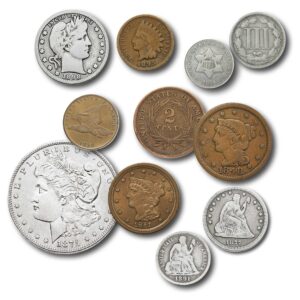American Treasures: A Numismatic Journey through Famous US Coins and the Legends Who Touched Them
Coins are not just pieces of metal; they are artifacts of history, carrying stories of the past within their tiny frames. In the United States, famous coins have circulated through the hands of some of the most iconic figures in American history. From Wyatt Earp to Billy the Kid, these legendary individuals, whose lives were intertwined with the Old West, often encountered coins that are now cherished as numismatic treasures. In this blog post, we will take a captivating journey through the annals of American history, exploring some of the most famous US coins and the iconic individuals who may have crossed paths with them.

The Flowing Hair Dollar: America’s First Silver Dollar
Our journey begins with the Flowing Hair Dollar, minted in 1794 and 1795. This historic coin is America’s first silver dollar, and its creation marked a pivotal moment in the country’s numismatic history. Although this coin predates many of the more famous figures we will discuss, it provides an essential backdrop to our story.
The Flowing Hair Dollar was in circulation during the early days of the United States, and it is likely that many influential figures of the era, such as George Washington, Thomas Jefferson, and Benjamin Franklin, handled these coins. This coin symbolizes the birth of American currency and the beginning of a new nation, and while we can’t pinpoint its exact journey, it undoubtedly touched the hands of some of the Founding Fathers.
The Morgan Silver Dollar: A Wild West Favorite
Jumping forward a century, we find ourselves in the tumultuous times of the Wild West, where figures like Wyatt Earp and Billy the Kid became legendary for their exploits. The Morgan Silver Dollar, minted from 1878 to 1904 and again in 1921, played a significant role in this era.
One of the most famous incidents involving the Morgan Silver Dollar took place in Tombstone, Arizona, in the early 1880s. This was the heyday of Wyatt Earp, a lawman known for his involvement in the Gunfight at the O.K. Corral. The Morgan Silver Dollar, with its iconic design featuring Lady Liberty and the American eagle, was a common sight in the saloons and gambling halls of Tombstone. It exchanged hands countless times in the gambling tables and bars, often as part of high-stakes poker games.
Another character from this era, the infamous outlaw Billy the Kid, also likely encountered the Morgan Silver Dollar. While Billy the Kid’s life was marred by violence and crime, this silver coin served as a symbol of his era. Whether he won one in a poker game or received it as part of his loot, the Morgan Silver Dollar was a piece of history that mingled with the outlaws and lawmen of the Wild West.
The Indian Head Penny: A Glimpse into a Bygone Era
The Indian Head Penny, produced from 1859 to 1909, offers us a glimpse into the life of the common people during the latter half of the 19th century and the early 20th century. While it may not be directly associated with famous personalities like Wyatt Earp or Billy the Kid, it circulated widely during their time and allows us to understand the economic conditions and everyday life of the period.
The Indian Head Penny is adorned with the profile of Lady Liberty wearing a Native American headdress. Its design reflects the changing dynamics in the United States during that period, as settlers moved westward and interacted with indigenous populations. It serves as a symbol of the cultural exchange, conflicts, and changes that defined America during the late 1800s and early 1900s.
The Gold Double Eagle: Glittering Fortunes of the Gilded Age
The Gold Double Eagle, minted from 1849 to 1933, is an extraordinary coin not only for its sheer beauty but also for the historical context in which it was used. This gold coin, with a face value of $20, was a symbol of the vast wealth and fortunes amassed during the Gilded Age.
Notable figures of the Gilded Age, such as the industrial magnate Andrew Carnegie and the business tycoon John D. Rockefeller, likely handled Gold Double Eagles on a regular basis. These coins were used for large transactions, and they epitomized the opulence and economic growth of the era. In the hands of men who shaped America’s industrial landscape, these coins were a tangible representation of the power and influence they held.
The Lincoln Penny: A Coin for the People
Fast forward to the 20th century, and we encounter the Lincoln Penny, first minted in 1909 to honor the 100th birthday of President Abraham Lincoln. This coin, featuring a profile of Lincoln on the obverse and wheat ears on the reverse, has become an integral part of American culture.
Though not directly associated with famous individuals, the Lincoln Penny carries immense historical and emotional significance. It was in circulation during pivotal moments in American history, such as both World Wars, the Great Depression, and the civil rights movement. It was a coin that passed through the hands of everyday people, reflecting the hopes and challenges of a nation.
Conclusion On American Numismatic Treasures
Coins are more than just currency; they are time capsules, bearing witness to the past and the people who shaped it. The Flowing Hair Dollar, Morgan Silver Dollar, Indian Head Penny, Gold Double Eagle, and Lincoln Penny are just a few examples of famous US coins that hold a special place in American history.
While we can only speculate about the specific journeys of these coins and whether they crossed paths with individuals like Wyatt Earp or Billy the Kid, their existence during pivotal moments in American history is undeniable. As we hold these numismatic treasures in our hands today, we are connected to the stories of those who came before us, making them not just relics of the past, but enduring symbols of the American experience.

